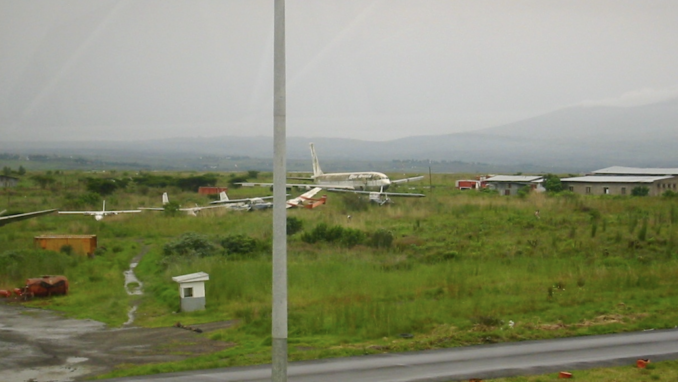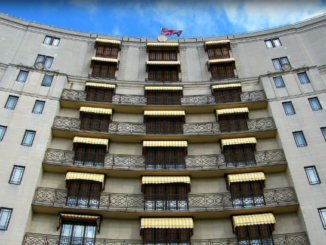
Airplanes at Kigali Airport,
Philip Kromer – Licence CC BY-SA 2.0
Having humiliated the Ugandan Army (UPDF), the RPF and the RCD in December crushed the remnants of the Congolese army and its Zimbabwean allies in Pweto, southeastern Congo.
On 16th January 2001, Kabila was sitting in his presidential office in Kinshasa when a kadogo (the small one meaning child soldier) bodyguard, Rashid Kasereka walked up and shot him in the back of the head.
The murderer’s identity not in doubt, theories and rumours circulated as to why at that precise moment, if he was prodded and if so, by whom. Years later when prodded, former RPF head of External Security Organisation confirmed he knew, “Check in Kinshasa Rashidi’s cell phone. In it, in the days running up to Kabila’s execution, there were a series of phone calls between Rashid and Kabarebe.” As he would have been only one of a tiny handful in the senior RPF (Kagame, Kabarebe being the others) to know exactly what was planned and what happened.
The CRD, having been effectively dismembered, its neighbouring states playing the role of bickering hyenas, DRC would only be nominally reunited after peace talks in South Africa’s Sun City casino in 2002.
A bigger concept also expired: the belief that the end of the Cold War superpower meddling meant that a coalition of progressive African governments, championed by like-minded “Renaissance leaders” could drive corrupt one-party rule from Central Africa. Certainly, within Africa, geo-politically, the UK, US now had in place their preferred proxy client.
Rwanda’s intervention (under Western friends’ orders) morphed into something else. While Kigali never ceased talking up the génocidaire threat in the Congo forests, security wasn’t the reason for maintaining troops there, even until today (M23). Using local rebel proxies as fronts, both Rwanda and Uganda’s militaries were vacuuming up Congo’s diamonds, gold, cobalt, columbo-tantalite, cassiterite and iron. Tropical hardwood timber, cattle herds, elephant tusks, quinine and tea were being trucked across the borders then exported abroad, miraculously rebranded as Rwandan and Ugandan produce.
The proceeds propped up the occupying countries’ treasuries, allowing them to win glowing, underserved praise from the World Bank, IMF and bilateral donors. In return, DRC got arms and military equipment that allowed the proxy rebel groups to continue the civil war. Congo’s riches were being used to fund its own destruction. The looting became so blatant that the UN Security Council (US, UK led on this issue) felt obliged to react. Applying the format used in Angola, Liberia (US interest) and Sierra Leone (UK interests), it appointed a “Panel of Experts” to investigate.
The Report tracked the way DRC’s exploitation by its two neighbours progressed and changed. In its early years it had been a simple case of mass looting. Stockpiles of minerals, coffee and wood in Eastern DRC had simply been removed from factories, farms, storage facilities. Manufacturing plants and machinery had been dismantled, private cars driven across the frontier, banks emptied of cash. Quantities were not small. One Rwandan operation, seven years of stockpiled coltan that took Rwandans about a month to fly to Kigali. Uganda focused on timber and coffee beans[1].
After that phase, both switched to active extraction. Soldiers controlled mines using child labour digging for gold and coltan, first trucked then flown across the borders. What stuck UN investigations was the contrast in rationale and style of both operations. For Ugandans, it was “catch-as-catch-can” who couldn’t give a damn about filling Uganda’s coffers, they were in it for themselves. Rwanda was different. Kagame had said Rwanda’s DRC operation had to be “self-financing”, in other words “profit-making” would have been more accurate.
Caught with their hands in the till, Uganda Government’s response to the UN report was to set up a commission of inquiry to investigate, presided by a British judge. There was no question of Rwanda doing likewise. Far from seeing it as something bad, it was viewed as something noble and exalted, as part of their mission to rule Congo. In essence Rwanda knew they were doing something atrocious, so Omertà was applied.
While a UN peacekeeping force was despatched to separate key players, the last 23,400 RPF troops who’d illegally occupied DRC for four years marched across the border. DRC’s exploitation didn’t end there. Rwanda became more discreet. Resources were and are still extracted, but much less obvious unless looking at M23. Kagame as always denies any involvement.
Kagame now bathed in “Western Friends” light was busy reinventing himself as a visionary leader who’d liberated Rwanda’s Tutsis virtually single-handedly, he increasingly wanted to be surrounded by impressionable young acolytes who had no memory of his faltering early steps in school and immediately after. In keeping acolytes on their toes, he makes sure they never know who is in or out of favour. And wanting to remain in power forever, he targets not only enemies but “friends” as well as going after people who haven’t done anything. Ensuring the signal is repeatedly sent out, that no one is safe, people ended up afraid of their own shadows, suspicious of oldest friends, whilst cynical, ensures the status quo.
With 2003 elections imminent, its first “multi-party” polls in history, Kagame called the inner cadres to discuss the poll percentage win. Despite the majority of the inner cadre expressing the need, even as a fig leaf, opposition and giving the electoral process credibility, Kagame and Kabarebe agreed on 100%. The opposition party found itself banned ahead of the election despite being a coalition with the RPF for years, but apparently no one noticed. Opposition campaign managers in the provinces, were arrested and paraded on TV, having to denounce their former leader in exchange for their lives.
Notwithstanding the pressure, when votes came in, they gave the opposition a bigger share than the RPF was willing to concede. An urgent call was put to the Ministry of Defence: vote stuffers were needed. The computer kept saying Kagame won so many votes, but the vote slips didn’t tally.
In certain areas, the soldiers did their job too well, with some places registering final tallies of 110% for Kagame. Fake votes loaded onto trucks to be taken to HQ, when there was an accident, the truck overturned and fake votes spilled out. The road had to be closed and military barricade set up to stop anyone noticing.
The final vote gave Kagame 95.1% (from his 14% Tutsi a and Hutu 85% population) whereas the “opposition” (Hutu) received 3% of the votes, with some votes yet to be counted. The end “official” result Kagame had given himself a tally only a handful of percentage points short of the 98.9% his predecessor Habyarimana, had routinely claimed in the polls. Mr Teleprompter was so impressed he copied the model.
Foreign donors were well aware of what had transpired. But they allowed themselves to be convinced by the RPF argument that a society struggling to heal from its genocide wounds was simply not ready for majority rule. The Tutsi minority safety came first. After failing Rwanda in 1994, the international community did so again in 2003 by allowing a dictatorship to take root. The US and UK became cowed by guilt.
The Missile
The plane. The other massive secret that radiates from the RPF story, deeper than who was behind the killing of Fred Rwigyema and the assassination of Laurent Kabila. The usual theories radiated within hours of the Falcon 50 explosion.
Initial claims that white men had been running from the unknown missile sight: Belgian UN peacekeepers, French paratroopers or mercenaries. Eventually the usual schism: the RPF: greedy for more than the Arusha Accords would yield and aware that envisaged elections would favour Hutu parties reducing the RPF to a cameo role, or it had been attacked by radical members of the Akazu clustered around Agathe Habyarimana. Once the Hutu Government had fled, leaving the scattered handiwork across the land, Western donors piling in to help had no difficulty accepting that version of events.
However, as years passed, the question of RPF responsibility showed a stubborn refusal to go away. When the ICTR was first established, with respected South African Judge Richard Goldstone as chief prosecutor, the ICTR certainly saw probing the plane’s downing as well within its scope. When ICTR investigators Jim Lyons (former FBI) and Michael Hourigan (Australian lawyer) were approached by three former RPF fighters claiming direct knowledge of Kagame’s responsibility, they excitedly called Goldstone’s successor, Canadian Louise Arbour to say they had compiled a dossier outlining grounds of prosecution. She ordered the investigation terminated and questioned the credibility of the men’s sources and queried their mandate to investigate the plane.
Arbour’s feisty successor, Carla Del Ponte, who made her name prosecuting the Italian mafia, insisted that her jurisdiction did indeed extend to the plane and secretly set up a Special Investigations Unit to probe that and other RPF crimes. Word must have got out, no surprise given that Rwanda’s intelligence service had placed informants among ICTR’s translators and were also, thanks to equipment provided by US, monitoring the court’s telephone, fax and internet traffic.
When Carla Del Ponte’s joint contract expired for both the ICTR and ICTY, she was forced by UN Sec Gen Kofi Anan to focus on the latter, and a Gambian took over her duties. “It is clear that it all started when we embarked on these special investigations. Pressure from Rwanda contributed to the non-renewal of my mandate,” Del Ponte later said[2][3].
The Evidence
When the Falcon departed Dar es Salaam on 6th April, RPF senior cadre, part of the Ugandan delegation called James Kabarebe, notified the plane was heading back to Kigali. The surface-to-air-missiles used were Soviet made.
They had been sold to Uganda by Russia, and only one side in the Rwandan conflict had ready access to Ugandan weaponry – the RPF. The original plan was a team within the 600 elite troop contingent brought into Kigali to guard Rwanda’s parliament building, where meetings and logistics were refined, would be used. A road ambush on Habyarimana’s presidential convoy was initially envisaged but RPF commanders couldn’t work out how to extract the team afterwards, so the focus shifted to air. The missiles were smuggled into Kigali hidden in a pick-up truck stacked with wood, a method tried and tested many times before. The original plan was to attack the presidential jet when it flew to Tanzania, but postponed due to fog. It was authorised (by Kagame) for the return flight[4].
It didn’t matter to Kagame that the fuse was lit and wasn’t bothered by how many people would die as a result, derailing the Arusha peace accords as he was bent on “absolute power.”
Footnotes
[1] Final Report of the Panel of Experts: On the Illegal Exploitation of Natural Resources
[2] Madame Prosecutor: Confrontations with Humanity’s Worst Criminals and the Culture of Impunity
[3] Del Ponte Says UN Caved to Rwandan Pressure
[4] Working Paper, Back to the Kigali Attack
© AW Kamau 2023



